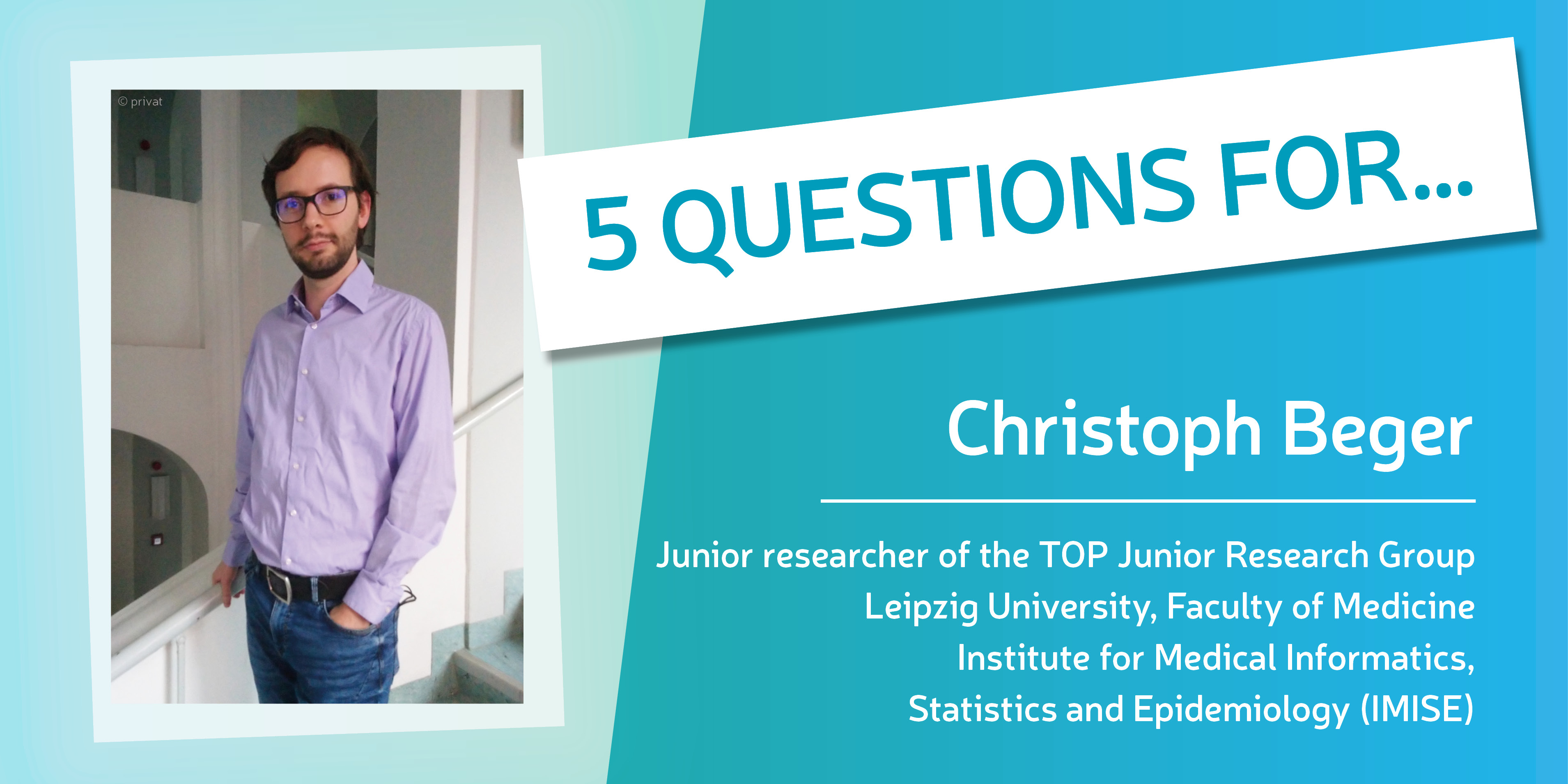
How algorithms can help improve medical research and patient care | 5 Questions for… Junior Researcher Christoph Beger
Christoph Beger is a junior researcher in the SMITH Junior Research Group “Terminology- and Ontology-based Phenotyping (TOP)” at the Leipzig University. The native Leipziger studied computer science and has been involved in the development of databases and web applications for research data for almost ten years. Since 2016, he has been working as a research assistant at the Medical Faculty of the Leipzig University. In this context, he has established a system for publishing and archiving medical research data and results at the Institute of Medical Informatics, Statistics and Epidemiology. In the Junior Research Group TOP, he is dedicated to the algorithmic phenotyping of medical data and the representation of medical knowledge in databases.
We talked to Christoph Beger about what algorithmic phenotyping is and why it can optimize research with medical data and thus patient care in the long term. He also revealed to us what the professional future looks like as a young scientist in medical informatics.
What are you working on in your junior research group and what is your special field of activity?
Our special field is phenotyping. This means that we try to automatically recognize certain characteristics or phenotypes of patients and model them with the help of ontologies and terminologies. Ontologies are constructs in which knowledge can be mapped. For example, they abstractly describe what a phenotype is and what subtypes exist. The mapped knowledge is formalized in such a way that it can be used for machine analysis.
We also build computer models that allow us to detect certain diseases or risk factors in patients at an early stage. In the same way, we can use phenotyping to find patients who meet certain criteria for study participation. Here is a concrete example: diabetes mellitus type 2. The aim here is to try to identify as early as possible whether a person has diabetes mellitus type 2 on the basis of existing diagnoses, laboratory parameters or prescribed medication. With our research group, we support this procedure by developing appropriate tools for this purpose. In principle, this is also my area of responsibility: I work on the development of these models, which serve as a basic framework for being able to display such phenotypes. I am also involved in software development. We provide a ready-made framework that we can make available to clinics or researchers for studies.
The subject is not easy for lay people to understand. How did you get involved yourself and what excites you most about this field?
Actually, the collaboration came about through the SMITH project, which is precisely about making patient data from routine clinical care more available to researchers. That’s the problem at the moment: we have a huge amount of data that is generated in the clinic, but we can’t really access it. We can’t just analyze the data; IT experts or biometricians who develop certain analysis scripts have to do the analysis. With the ontological approach, we want to simplify this process to ultimately enable early detection, support patient care, and reduce the burden on healthcare professionals.
The junior research group started work in mid-2021. How far along are you with your project at the moment?
At the moment, we have reached the stage where we have completed the first stage of the phenotypic model, so that phenotypes can be modeled. The execution of these models is also partially possible. Right now we are extending the calculations that are running in the background so that we can support even more use cases where phenotypes will be used. Example: We can calculate BMI or map the example of diabetes mellitus just described. But there are certainly more complex approaches where this is not yet possible. In this respect, we are still trying to sharpen the whole model a bit. What we are also working on at the moment is a web application in which researchers without IT knowledge can assemble such models themselves. They should then be able to run these on data sets, so that patients who meet certain criteria can be identified in the first step.
How would you like to develop professionally in the future?
I would of course be happy to continue working in the field of medical informatics. Perhaps exciting new projects will come along. I think this field is really extremely important for the healthcare system and the general population. In recent years, there has been a lot of public interest in the healthcare system, the processes there, and how to optimize them. Therefore, I would like to continue to be active there. I consider topics such as telemedicine, networking between service providers in the healthcare system, but also the standardized exchange of information between these providers to be very relevant. What’s also important to me: I’ve been involved with statistical evaluations in pediatric medicine, and I think that’s actually an area that’s being shortchanged right now. There should be more support for pediatric medicine. Furthermore, there should be more focus on prevention, which is relevant in the first five to fifteen years in children and adolescents.
Research in the SMITH consortium is important to me because…
we can improve accessibility to patient data from hospital care and thus also support research as well as patient care.

